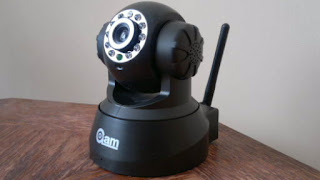Custom firmware
The current test firmware version supports 16MB ram / 4MB flash units only. Following features are available:
- Based on Linux version 2.6.38.2
- rt2800usb wifi network support (Ralink idVendor=148f, idProduct=3070)
- PixArt cmos usb camera (idVendor=1d0f, idProduct=1801)
- jffs2 writable root filesystem (2MB)
- jffs2 writeble user/data filesystem (~500KB)
- experimental software spi bus + sd/mmc, slow but enough to save camera snapshots, stream mp3 files etc.
- v4l camera interface
- mathopd http server (with cgi support)
- simple login subsystem (users account / passwords)
- inetd
- telnetd
- ftpd
- userspace binary to controll horizontal/vertical stepper motors
The complete camera firmware is divided into 3 images:
- linux kernel image
md5sum: d4433c1c74a45650602ef3dfcb86df5a zImage
- root filesystem
md5sum: da562a3fc82655ea4d25d4ceadff1865 romjffs2.img
- user filesystem (empty/pre-allocated fs mounted over /data, useful if you haven't done the sd/mmc mod yet)
md5sum: 4d4fe44522508b09381ddb39ad9a61f8 userfsjffs2.img
Warning: Proceed at your own risk, ONLY if you are 100% sure that you have a valid backup and know how to perform the restore operation. There are many variants of those so-called ipcam/foscam clone cameras and not all are compatible. Also, this firmware is an early test version only, I can NOT be held responsible if something breaks, melts, burns as a result of using it !
So delete existing flash partitions (except the Image 0), setup a DHCP server on your host machine and upload each new image using the following commands:
Kernel image:
ft 1 linux 0x7F020000 0x00008000 -acx
Root fs:
ft 2 root 0x7F170000 0x7F170000 -f
User fs:
ft 3 userfs 0x7F380000 0x7F380000 -f
Instead of using dhcp/tftp "ft" you can use "fx" command and upload via serial cable - it's much slower (helps in case you don't have dhcp/tftp utilities)
When uploading individual images, one should see messages like below:
bootloader > ft 2 root 0x7F170000 0x7F170000 -f
Wait for auto-negotiation complete...
OK
100MB - Full
DHCP DISCOVER...
DHCP REQUEST...
DHCP ACKed...
IP Address. . . . . . . . . . . . : 172.16.72.4
Subnet Mask . . . . . . . . . . . : 255.255.248.0
Default Gateway . . . . . . . . . : 172.16.72.1
Waiting for download ...
TFTP client: 172.16.72.5
Download OK, file size:2097152
Flash programming ...
................................
When all files are successfully uploaded, the bootloader image table should look like this:
bootloader > ls
Image: 0 name:BOOT INFO base:0x7F010000 size:0x00000048 exec:0x7F010000 -f
Image: 1 name:linux base:0x7F020000 size:0x0013B358 exec:0x00008000 -acx
Image: 2 name:root base:0x7F170000 size:0x00200000 exec:0x7F170000 -f
Image: 3 name:userfs base:0x7F380000 size:0x00070000 exec:0x7F380000 -f
If that's the case, issue the "boot" command, hopefully after a while on the console the boot messages should be visible:
usb 1-1: new full speed USB device using nuc700-ohci and address 2
usb 1-1: New USB device found, idVendor=1d0f, idProduct=1801
usb 1-1: New USB device strings: Mfr=16, Product=96, SerialNumber=0
usb 1-1: Product: USB2.0_Camera
usb 1-1: Manufacturer: PixArt Imaging Inc.
uvcvideo: Found UVC 1.00 device USB2.0_Camera (1d0f:1801)
VFS: Mounted root (jffs2 filesystem) on device 31:2.
devtmpfs: mounted
Freeing init memory: 76K
input: USB2.0_Camera as /devices/platform/nuc700-ohci/usb1/1-1/1-1:1.0/input/input0
usb 1-2: new full speed USB device using nuc700-ohci and address 3
usb 1-2: New USB device found, idVendor=148f, idProduct=3070
usb 1-2: New USB device strings: Mfr=1, Product=2, SerialNumber=3
usb 1-2: Product: 802.11 n WLAN
usb 1-2: Manufacturer: Ralink
usb 1-2: SerialNumber: 1.0
********************************************************
starting userspace: custom_cam kernel v1.0, rootfs v1.0
news/updates: http://customcam.blogspot.com/
********************************************************
At boot time both eth0 and wlan0 are enabled with these ip parameters:
/ $ ifconfig
eth0 Link encap:Ethernet HWaddr 00:02:AC:55:88:A8
inet addr:172.16.72.111 Bcast:172.16.79.255 Mask:255.255.248.0
UP BROADCAST RUNNING MULTICAST MTU:1500 Metric:1
RX packets:1 errors:0 dropped:1 overruns:0 frame:0
TX packets:0 errors:0 dropped:0 overruns:0 carrier:0
collisions:0 txqueuelen:16
RX bytes:60 (60.0 B) TX bytes:0 (0.0 B)
wlan0 Link encap:Ethernet HWaddr 00:E0:4C:B4:61:01
inet addr:172.16.72.112 Bcast:172.16.79.255 Mask:255.255.248.0
UP BROADCAST RUNNING MULTICAST MTU:1500 Metric:1
RX packets:3 errors:0 dropped:0 overruns:0 frame:0
TX packets:3 errors:0 dropped:0 overruns:0 carrier:0
collisions:0 txqueuelen:1000
RX bytes:397 (397.0 B) TX bytes:423 (423.0 B)
The wlan0 interface will try to associate with a wireless network (WPA) sid="wifi1" using password="secret123". All the network init can be adjusted by editing /etc/net.sh and /etc/wpa_supplicant.conf files. Pay attention to the non-standard network mask 255.255.248.0 (heh, yes that's my home setup).
If all went correctly, your camera system can be accesed by:
- telnet / ftp - there're two initial accounts (root and pwoz, password is 1q2w3e for both users)
- web browser - default URL: http://172.16.72.112/move.html - a test page to move the camera to a desired direction and get the image snapshot. (it's intended for test only, don't use it too much - every snapshot is saved to jffs filesystem so it might put additional strain on the flash chip)


